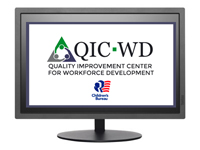Child Welfare Quality Improvement Center for Workforce Development (QIC-WD)
Date of this Version
10-18-2019
Document Type
Article
Abstract
The Quality Improvement Center for Workforce Development (QIC-WD) partnered with the Virginia Department of Social Services (VDSS) in 2017 to conduct research examining the efficacy of technology interventions aimed at reducing child welfare staff turnover and improving child welfare outcomes. Virginia is a state-supervised, countyadministered child welfare system. The state elected to study the implementation of and outcomes from job modernization technology interventions in 18 localities. These 18 localities represent a workforce of approximately 450 of the state’s 2,200 frontline staff. The intervention is occurring in multiple phases: (1) transcription services; (2) a mobility technology application; and (3) a Comprehensive Child Welfare Information System (CCWIS). This post highlights lessons learned from the implementation of the transcription services. VDSS implemented, and the QIC-WD team evaluated, the implementation of transcription services in 2018. Analyses used data from: 1. a baseline staff survey; 2. a series of post-rollout short surveys; 3. worker-level transcription usage records; 4. case-level administrative data reflecting documentation practices over time; and 5. caseworker, supervisor, and agency director focus groups reflecting on lessons learned. VDSS has seen positive results from the introduction of transcription and has gleaned valuable insights from analyses identifying worker characteristics associated with the adoption of technological supports. Findings indicate that while transcription services were not uniformly embraced, they were associated with improvement in the timeliness of casework documentation and increased flexibility for staff, including the ability to complete administrative tasks while out of the office. Analyses also revealed that adoption of the transcription support services varied by worker age, the types of cases served, worker perceptions of agency support, perspectives on transcription, and intent to leave their job. Specifically, staff who: • Were younger were more likely to adopt the technological support; • Worked on on-going child welfare cases or had a caseload involving multiple case types, were more likely to adopt the technological support; • Indicated lower levels of perceived support from the agency when something on their caseload goes wrong, were more likely to use the technology. • Indicated a higher likelihood of leaving the job were less likely to engage with using the transcription service and, • Professed a higher opinion of transcription services before it was rolled out were, inexplicably, less likely to use it. The implementation and evaluation work done to date have yielded valuable lessons about how the day-to-day practice of child welfare casework is changing due to the flexibility introduced by technological advances. These findings will guide worker and supervisor training, have informed the state’s efforts to prepare locality administrators, and enhanced implementation and evaluation planning for the subsequent technology interventions.
Included in
Industrial and Organizational Psychology Commons, Performance Management Commons, Public Policy Commons, Social Welfare Commons, Social Work Commons, Training and Development Commons

